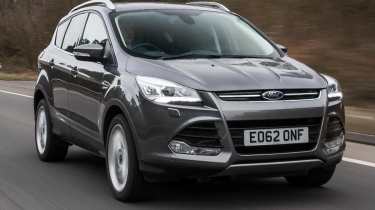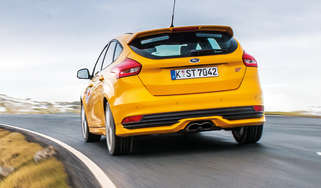2013 Ford Kuga 2.0 TDCI Powershift review
The new Ford Kuga SUV is larger than the car it replaces. Can it be as fun to drive?
What is it?
The new Ford Kuga, a mid-sized 4x4 crossover with a mildly sporting pretence. It replaces the old Kuga, easily one of the better-handling compact SUVs, while increasing in size. Prices for the Kuga start at £20,895 for the most basic models, rising to £29,795 for the top-spec Titanium X model, tested here.
Technical Highlights?
Unlike the old model, Ford’s new Kuga is a more global proposition and actually replaces the much larger US Escape model. It uses the ‘Global C’ platform – which also underpins the current Focus – meaning a good selection of engines and well-tested mechanicals. No doubt the 2-litre TDCI will be the big seller, available with 138 or 161bhp, however there’s also the option of the 148bhp 1.6-litre EcoBoost petrol engine.
Ford has abandoned the old Haldex four-wheel-drive setup in favour of its own in-house system, although the Kuga is still also available as a front-driver. Use of an electronically controlled clutch means that up to 100 percent of power can be sent to the rear. Standard on all models is also the company’s clever electronic torque vectoring system.
Our test car came equipped with the optional hands free power tailgate option, which can be opened by waving your foot under the rear bumper. It might seem slightly gimmicky, but proved quite useful when loading, and is something Ford is propositioning to set the Kuga apart from the competition.
More reviews
Reviews
What’s it like to drive?
It feels very grown up after the previous Kuga – sadly losing that ‘hot hatch on stilts’ feeling. Then again, it’s a much larger car, and is still fantastically composed. With very little body roll and supple suspension, the compromise is spot on – something Ford always seems to get right. The steering is well weighted and accurate, giving confidence to really lean on the Kuga in fast corners.
Under normal driving conditions, the four-wheel-drive system is virtually undetectable, and only when pushed can you feel the power being distributed towards the rear. The 2-litre diesel engine, tested here in 161bhp state-of-tune, provides decent performance. It’s quiet, although not as refined or frugal as similar engines from Volkswagen or BMW.
The optional Powershift six-speed automatic fitted to our test car feels a generation behind the leading dual-clutch offerings, often not knowing which gear to be in. Sport mode gives slightly more eagerness, and the car will hold onto ratios slightly longer. The Powershift ‘box also has the ability to manually select gears via a small rocker switch on the selector, with no steering wheel paddles. Not the most intuitive system.
How does it compare?
The Kuga sits comfortably alongside the many sub-£30k crossovers on the market, such as the Mazda CX-5, Nissan Qashqai and VW Tiguan – but the larger size means it can punch above its weight offering an alternative to larger SUVs like the Hyundai Santa Fe. Standard levels of equipment are good.
Anything else I need to know?
Unlike most cars in this category, opting for the automatic gearbox will actually result in a higher CO2 figure and increased fuel consumption.
Specifications
| Engine | In-line 4-cyl, 1997cc, turbodiesel |
| Max power | 161bhp @ 3750rpm |
| Max torque | 251lb ft @ 2000rpm |
| 0-60 | 10.4sec (claimed 0-62) |
| Top speed | 122mph (claimed) |
| On sale | Now |



